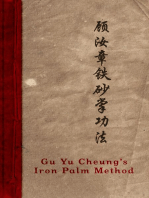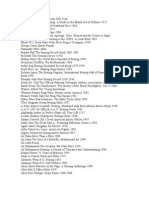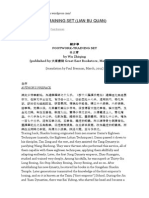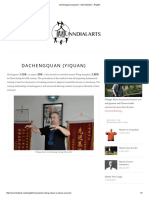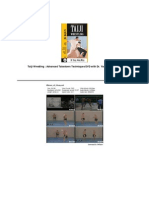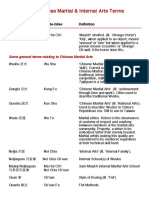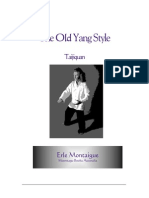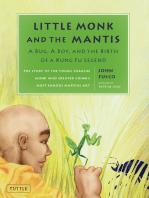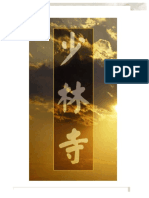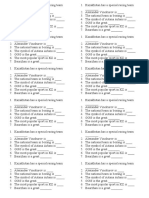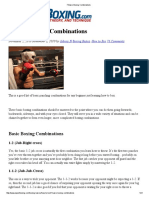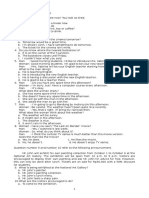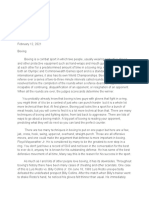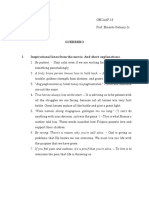Shaolin Collection 3
Shaolin Collection 3
Uploaded by
TomiCopyright:
Available Formats
Shaolin Collection 3
Shaolin Collection 3
Uploaded by
TomiCopyright
Available Formats
Share this document
Did you find this document useful?
Is this content inappropriate?
Copyright:
Available Formats
Shaolin Collection 3
Shaolin Collection 3
Uploaded by
TomiCopyright:
Available Formats
:
Shaolin Collection - 3
The Principles of Chinese Boxing
By: Uwe Schwenk (Ying Zi Long)
Shaolin Collection - 3: The Principles of Chinese Boxing
1
Introduction
This is the third in a series of documents, which are in my opinion
considered essential for studying Shaolin Gong Fu.
About this Library
Most of these documents are translations of historical texts which are just
now (2003) beginning to emerge. For this library, only the texts considered
as core by the author to the study of Shaolin were selected. While some of
the readers might question some of the texts in this collection, please bear
in mind, that Shaolin has a different meaning for every person studying the
art.
Shaolin Collection - 3
Chen Zhaopi, the 18th generation Chen family master and master of Chen
Xiao Wang, Chen Zhenglei, Chen Shitong, and Wang Xian, said the
following: “If one cannot come to recognize how the weight moves distinctly
back and forth between the two legs, then the upper and lower body cannot
work together and connect. If the upper and lower body cannot connect,
then you cannot absorb the opponent’s force. If you cannot absorb the
opponent’s force, you cannot use his force.”
After two years of dedicated practice, Mr. Yan’s teacher, Chen Quan
Zhong, told Mr. Yan that he still had no Kung Fu, but had only begun to have
a little root. Therefore, it would serve us well to look closely at how to attain
this principle of rooting, because we can safely say that if there is no
rooting, there will be nothing else. The study of the “internal” will give us the
secret of true “rooting” and teach us how to get power from the ground.
The great internal arts have various ways to achieve the skill of rooting. In
the art of Xing-yi (mind-will boxing) much time is devoted in particular to
developing the San ti Shi or “Three Body Posture.” In the style of Bagua
Zhang (eight diagram boxing), they use the idea of walking in a circle in
order to build up the root. In Tai Ji Quan one develops the root by studying
what the body must do in order to keep the weight’s center balanced while
moving very slowly. Push hands practice, a two person touching exercise,
then uses speed in order to develop this balance under more difficult
circumstances.
Even though each art uses different methods in order to build and develop
the root, other factors are important such as intensity and regular practice.
Zhang Ju, who was a master in the art of Xin-Yi, practiced so hard that he
would finally collapse and fall down asleep. Sun Lu Tang, one of the most
Introduction: About this Library
2
famous internal boxers in Chinese history, practiced the “plowing step”
wherever he went during the day. Even while standing around he would be
practicing. Chen Xiao Wang practiced so hard he could barely bend his
knees after practice.
In part 3 of the Shaolin collection, we will evaluate the 11 principles of
Shaolin boxing.
Introduction: Shaolin Collection - 3
3
The Principles of Chinese Boxing
Rooting
Rooting is a skill of keeping a heavy and relaxed energy in the lower half
of the body. One who is rooted is bottom heavy. The two words most often
connected with rooting are "sink" and "relax."We add the word structure
because this state of rooting is enhanced when one is in a proper body
alignment.
The most obvious benefit of rooting for combat is greater stability. It also
provides deceptiveness. If the upper body is attacked, it becomes a false
target. It yields in a supple manner while the lower body remains stable,
then springs back for counterattack.
Rooting entails what we call "hanging posture," which is so named
because we visualize the body suspended from a thread attached to the top
of the head (at the energy center known as the `baihui'). The shoulders are
naturally rounded, not arched back in military fashion. The head is erect and
the spine straight. In fact, we want a vertical line from the baihui to the base
of the trunk between the two legs. This line is known as the central axis.
Whereas the center line runs along the surface of the body, the central axis
runs through its interior. The tan tien and the baihui lie on the central axis,
but the tsun kwan energy center (also known as the "third eye") lies off the
axis, nearer to body's surface.
To achieve a vertical central axis, the hips must be relaxed. Many styles
teach a tucked hip. Irregardless,the lower spine must be straight and full
rather than curved. A straight spine is also important for good chi flow which
nourishes the kidneys and provides good health.
To get the idea of the hanging posture, first stand with your legs straight.
Now visualize the thread attached to your baihui point and let your legs (in
fact, your whole body) sink and relax. The knees bend and the torso drops.
The upward pull from the imaginary thread provides form to the otherwise
relaxed body.
In hanging posture, you want to feel a heaviness in your tan tien, as
though it is pulling you down into the earth.
It is very important that the body relax and remain very straight. One
should not lean back or forward. Looking from the side, the ear, shoulder
and hip should be in a vertical line running down to the bubbling well point
below the ball of the foot in the center of the foot.
Rooting is thus enhanced by two key visualizations: the suspension of the
body by the thread at the baihui and the pulling downward of the tan tien.
The combination of these tends to stretch the body at both ends, which
removes some curvatures in both the upper and lower spine.
The Principles of Chinese Boxing: Rooting
4
Rooting promotes the development of chi not only by establishing a
straight spine and concentrating chi in the tan tien, but also by virtue of its
sunken posture. A low stance is conducive to the circulation of chi to the
"bubbling well" cavities in the soles of the feet. When this circulation is well
developed, you can maintain your root in a higher (but still somewhat
sunken) stance, which may be more appropriate for the combative aspects
related to changeability skills.
(Note that, contrary to a common misconception, rooting is not synon-
ymous with an extremely low stance. You can be rooted in a very low stance
or in a moderately low stance. You can even be in a very low stance and yet
not rooted, particularly if the depth of your stance sacrifices hanging
posture.)
Rooting is relatively straightforward when you are standing in one spot and
thinking of nothing else, but is much more difficult to incorporate naturally
into all you do in martial art. In particular, it is a challenge to stay rooted as
you move about, especially when under attack. The heat of combat typically
causes energy to rise to the upper body, unless one has been thoroughly
trained.
This is not to say, however, that rooting is inimical to mobility. On the
contrary, rooting is necessary to mobility, particularly the changeable
footwork of Chinese boxing. Since the combative encounter is filled with the
need for changeable footwork, it is important that this principle of rooting be
developed in transition. My point is simply that the skill of rooting is difficult
to learn. A vision of its benefit is important as it will provide the patience and
perseverance until one makes rooting a reality.
It is relatively easy to move across the floor with the knees bent and the
weight sunk if you accomplish this outside the framework of hanging
posture. Just run forward in a crouch. But to step smoothly across the floor
in perfect hanging posture is very difficult. The hips tend to tighten and the
central axis tends to tilt back and forth and bob up and down. When one is
able to step smoothly while preserving hanging posture, we say he has a
floating or gliding central axis. Probably Tai Chi and Pa-Kua develop this
skill more than most arts. A master of these arts can appear ghost-like.
When Kai Sai first met his Pa-Kua instructor, the great master Wang Shu-
chin, he was amazed by the way Wang seemed to float across the floor. At
first he was amazed how Wang was able to propel himself, for he hardly
seemed to move his feet!
Rooting entails the use of the ground as a lever, not only when clashing
with an opponent but even in the simple act of walking. One should have
spring energy (potential or kinetic) in the feet at all times. The bend in the
legs, in addition to providing a low center of gravity for stability, creates a
coiled spring effect. Upon uncoiling, the energy is generally forward, not
The Principles of Chinese Boxing: Rooting
5
upward. A rooted boxer is ready to explode forward (in a variety of direc-
tions) at any instant. The angle between the pushing foot and the tan tien
determines the potential for this 'spring'.
For combat, it is not entirely accurate to speak of a "vertical" central axis.
What we really want is a very slight forward inclination, which enhances
spring-loaded energy and forward pressure. This slant, however, is almost
imperceptible. It is more felt than seen. Beginners are best advised to
concentrate on developing a perfectly vertical central axis, since their
habitual posture is typically light-years off them ark, and since if they think
about slanting they will almost certainly overdo it.
In martial art circles, the term "rooting" is commonly associated with the
internal martial arts. However, just as many practitioners of these arts are
failing to practice the arts as Chinese boxing, many spokesmen for these
arts have a different conception of rooting. To many, rooting means being
immovable. They speak of visualizing stakes driven into the ground through
their feet, or of being chained to the center of the earth.
These analogies are useful up to a point. Rooting does entail stability, and
we have exercises where a partner pushes you from different angles to test
your balance or to test one's ability to use the alignment to absorb another's
force into the ground. But if you are pushed too hard, you must move out of
the way of the force (staying rooted as you move).We want to visualize our
energy extending through the soles of our feet,anchoring well below the
surface on which we stand. But we ourselves are not "anchored" in the
sense of being fixed to one spot. The notion that rooting means immovability
is a gross misconception.
This misconception commonly pervades the exercise of push hands. For
some, immovability is the fundamental rule, the criterion for success. If
someone pulls you, you're supposed to "root down" and resist the pull. But
in Chinese boxing push hands, if someone jerks on you, you go with the
force, blending with it and stepping in to attack.
Some martial artists propose you should be light in the body and heavy in
the feet. In Chinese boxing, rooting dictates the reverse. (Heaviness,
however, does not mean tension. This will be further discussed in the
section on body state.) To say that the feet must move in combat is an
understatement. The feet must be hypersensitive, ready to move at any
instant, sometimes in response to subtle stimuli. This is not a compromise of
rooting; it is one of the key effects rooting is intended to achieve. Rooting
thus dove tails very closely with the six-nine theory of mobility and change.
Rooting adds a new dimension to your capabilities. It enables you to be
highly deceptive in combat. Ordinarily, when an opponent runs into your
upper body or your upper extremities, he will feel an energy that matches
your lower body as well. Rooting changes this entirely. Dealing with a boxer
who is rooted is like dealing with two adversaries at once, one corre-
sponding to his upper body and the other to his lower body. Your opponent
The Principles of Chinese Boxing: Rooting
6
may gain control of your upper body, but he will not have a direct lever
controlling your lower body. If you maneuver your lower body deftly, you can
still snatch victory away from him.
Rooting helps hide your essence. It can give you an undertow effect upon
interfacing with an opponent.
Important as rooting is, there are occasions in combat when you should
not root. Yielding takes priority over rooting. Normally, rooting and yielding
work together, but if a projection is aimed below your tan tien (such as an
opponent diving in for a low tackle), you give down low, possibly bending
over to maintain balance. You can ride out the force, attempting to drive it
into the ground. This is called "riding the waves" temporarily, until the force
is dissipated or neutralized. But such situations are anomalous. The odds
are that a projection will come in above your tan tien. You never know what
will happen in an encounter, but chances are strong that you will need to
root most of the time in the average encounter.
There are many levels of rooting. You can get some degree of proficiency
in a few minutes of guidance. First, you learn to stand in a rooted state.
Then you learn to receive force without being toppled while standing still.
Next, you learn to shift weight properly in a rooted state. Then you learn to
move across the floor while staying rooted. This is a great gulf to cross.
Then you learn to receive force without being toppled while in motion.
The ultimate goal is to make rooting a part of your being, so that when you
practice, it is no longer thought about. A tremendous amount of work is
required to accomplish this.
Yielding
Yielding is the skill of not resisting force, or of avoiding confrontation with
force.
This skill can save your life if you are ever attacked by someone who is
more powerful than you are, for in a direct confrontation, superior force
almost always wins. More than any other principle, yielding gives the weaker
and smaller person a realistic chance against the stronger, larger opponent.
In the theory of Chinese boxing, yielding is conceived as a martial tactic.
To stand completely inert while someone attacks you with a knife may be a
form of yielding in a broad, philosophical sense, but not in a martial sense.
Let us investigate, then, how yielding can serve to vanquish an attacker.
There are basically three ways to defend against an incoming projection.
These methods differ radically in the degree to which they confront force (or,
conversely, in the degree to which they yield).
First, you can stop the projection dead in its tracks, meeting force with
force in a head-on collision. I call this method "head-on blocking."
The Principles of Chinese Boxing: Yielding
7
Second, you can redirect, rather than stop, the incoming projection, so
that it misses its target. This method also makes use of force, but requires
less force than does head-on blocking. The force is applied to divert the
projection from its intended trajectory, rather than to stop it cold. This
method is known as "deflection."
The third method is to move out of the way of the projection. This can be
accomplished by rotating or bending your body, by shifting your weight,
stepping, or all of the above. The projection reaches the point at which it
was aimed, but you no longer occupy that position, so it falls on empty
space. This method is known as "evasion." It requires no force at all, as it
does not in the slightest alter the trajectory of the incoming projection. It
does, however, require expert timing. If you move too late, you get hit. If you
move too early, your attacker can change course and follow you.
Methods one and three lie at opposite ends of the spectrum from 'hard' to
`soft'. Head-on blocking is pure force, no yield. Evasion is pure yield, no
force. Method two establishes a continuum between these extremes. The
degree of confrontation in a deflection can vary greatly, depending on the
skill of the practitioner. Deflection can be accomplished in a soft manner,
with minimal use of force, or in a hard manner, with pronounced reliance on
force. At its best, deflection lives up to the ideal of the Tai Chi "four ounce"
theory, which states that four ounces, properly placed at the right instant,
can subdue a thousand pounds. It is possible to blend evasion and
deflection. In a pure deflection, you do not move, but move the projection. In
a pure evasion,you move yourself rather than the projection.
In a combination of evasion and deflection, you move both yourself and
the projection. In a combination, each component may be executed less
than optimally. By itself, the evasion or the deflection might diminish the
assault only to the point where you receive a glancing rather than a solid
blow, but the two in concert prevent your being hit altogether.
Theoretically, you can evade a punch without ever contacting your
opponent. However, an energy boxer typically will intercept and stick to the
punching arm even when evading. He does this, first of all, for `insurance'.
If his evasion is less than perfect, he can fall back on deflection (or a
combination of evasion and deflection). This provides him with a safety net.
Without contact, he has no margin for error.
Secondly, even if the boxer is completely confident in his evasion skill, he
still wants to establish and maintain contact so he can read his opponent's
energy. Information rendered by touch can be factored into the evasion
itself, if the interception occurs early enough. Speed plays a vital role here.
A high level of skill is required to intercept, interpret, and correctly react to a
fast projection. For the sake of efficiency, evasive motion usually begins as
soon as you sense (visually, in most cases) an incoming projection. At the
The Principles of Chinese Boxing: Yielding
8
same time, the limbs move to intercept the projection. Once contact is
established, the evasion can be adjusted so that it is uniquely appropriate
for the given energy.
Another reason for intercepting and sticking to the projection is that
contact opens the door to controlling your attacker.
Yielding distinguishes hard-style martial art from soft-style martial art.
There is a common misconception that a `hard-style block' is one that uses
a closed fist rather than an open hand, or employs a straight line rather than
circular motion, or tenses the muscles rather than keeping them relaxed. In
truth, a hard-style block is any technique that interferes with the incoming
projection (the degree of hardness depends on the degree of force
employed in the interference). A circular technique with an open hand and
relaxed muscles is a hard-style block if it derails the projection. A linear,
tense, closed-fist karate block is a soft-style block if you apply it while
shifting your body out of the projection line, using the block merely as a
protective guide.
Hard-style blocks work only if you are sufficiently powerful to make them
work. In the case of head-on blocking, you must be more powerful than your
attacker or he will blast through. In fact, you had better be considerably
more powerful, since in a collision between near-equal forces, it is possible
for both participants to get hurt. In the case of deflection, you can succeed
even if you are not quite as powerful as your attacker, but the gap between
his power and yours cannot be too great, or his projection will deflect your
intended deflection. The closer your deflection lies to the "soft" end of the
spectrum, the less your deflection relies on force and the greater the power
gap you can afford. Evasion, of course, works no matter how much more
powerful your opponent is (but if he has a tremendous advantage in speed
as well, you are probably a goner).
So far, our discussion of yielding has concerned methods of dealing with
an incoming projection-of coping with force that is being `pushed' at you.
But force can pull as well as push. As noted in the section on rooting, when
someone pulls on you, you should go with the pull rather than resisting it.
This is another variety of yielding.
Yielding is generally a defensive skill, but we want to accomplish it with an
aggressive orientation. We want to yield in a manner that will allow us to
take the offensive immediately, or at least as soon as possible.
If someone punches at you, you don't want to yield by jumping back out of
the way, as this delays seizing the initiative. You are back to ground zero.
(Moreover, this tactic cannot be relied on consistently. It will work if your
opponent is only jabbing, but if he is charging forward you are in trouble.
Other things being equal, one man can move forward faster than another
man can move backward. If all you know how to do is back up, you will soon
be overwhelmed. Or, worse, you will find your back to a wall.)
The Principles of Chinese Boxing: Yielding
9
Thus, when yielding to an attack, you want to be just barely missed. You
want to stay as close as possible to your attacker, so you will be in position
to take over.
If you find it necessary to yield backward, you should do so with forward
pressure. You must learn to maintain forward pressure even in retreat, so
you can read your opponent's intentions. You do not want to continue
withdrawing after the force is dissipated; rather, you want to shift smoothly
into forward pressure in advancing mode.
Preferably, though, you will evade not backward, but obliquely. For the
sake of efficiency, you want to evade the projection while simultaneously
moving in to counterattack. (This is another instance of yielding with forward
pressure. Forward pressure, i.e., pressure toward your opponent's center,
need not be on a straight line; it can be circuitous,to avoid collision with
oncoming force.)
Yielding obliquely requires a knowledge of line and angle. You want not
only to vacate the line of projection, but to position yourself so you can
attack your opponent on a weak angle.
Indeed, every yield should be effected with due consideration of line and
angle-of your weak angles and your opponent's, and of your respective lines
of attack. For example, in yielding backward, you do not want to do a deep
back-bend, as this will expose your groin to attack.
Not only line and angle, but several of the other principles as well must
guide yielding if it is to achieve its full potential. Rooting, body state, six-
nine theory, forward pressure, and centeredness all have key roles to play.
Yielding requires that you be highly mobile, and you want to be perfectly
balanced as you move about. Rooting is thus vital to yielding (with the previ-
ously noted exception of yielding to a projection below the tan tien).
Proper body state is also essential, as fluid yielding is possible only when
one maintains a supple body that is relaxed within movement.
When yielding, you do not want to place yourself at an extreme, where
your options for change will be limited. Rather, you want to remain in six-
nine mode. Mobility must be predicated on six-nine or changeable footwork.
I have already pointed out the role of forward pressure in both backward
and oblique evasion. But yielding, as we have seen, can mean submitting to
a pull as well as evading a projection, and forward pressure plays a role
here, too. If your opponent pulls on you, he will likely pull not quite toward
his center, but off center somewhat. If this is the case, your upper root
should yield in the direction of the pull while your lower root advances along
central line. This will enable you smoothly to use his pull as an impetus for
attack.
Centeredness relates to forward pressure in that one must have a sense of
his opponent's center if he is to generate pressure toward that center. Since
forward pressure plays an important role in yielding, centeredness is thus
The Principles of Chinese Boxing: Yielding
10
likewise important to yielding. Additionally, effective yielding requires that
one have an acute awareness of his own center,so that if a projection is only
slightly off center, he will be sensitive enough to yield in the appropriate
direction.
Yielding is seldom seen in martial art, or in any athletic activity for that
matter. Its rarity, fortunately, enhances its combative efficacy.
If an attacker is unfamiliar with yielding, he will expect to land his blow on
a solid target, and will likely be drawn off balance when that target yields.
Whereas an energy boxer is trained to unleash power in six-nine mode, the
average fighter tends to over commit when projecting. This can be a fatal
error.
If you have ever climbed a flight of stairs in the dark and overestimated the
number of steps, you know the feeling of reaching for a step that isn't there.
Imagine experiencing this same disorientation in combat, when you are
facing a trained opponent who will ruthlessly exploit your predicament,
counter attacking at the instant of your greatest vulnerability. The skill of
yielding enables the energy boxer to be "the step that isn't there." Like the
floating central axis, fluid yielding gives a boxing master a ghost-like quality.
Ideally, we would like to yield in a way that enables us to seize control of
the very energy to which we are yielding. Pa-Kua excels at this, using an
incoming projection to create centrifugal or centripetal force to be wielded
against the attacker. (The first type of energy arises in the single palm
change, the second in the double palm change.)
Although yielding can lead to devastating offense, it is risky to make
yielding the centerpiece of your fighting strategy. If you let your opponent
attack you with the intention of yielding and counter attacking,you are
gambling everything on the success of your yield. If your opponent is Mike
Tyson and your yield is less than textbook-perfect, he may land only a
glancing blow that still packs enough power to put you away, or at least stun
you and set you up for the finishing blow. It may be wiser to take a more
aggressive approach, initiating the attack. We learn to yield because there
will be times in combat when we are under attack, but being under attack
should usually not be our preference. Yielding is perhaps best viewed as a
way of cutting our losses, or of recovering from a position of disadvantage.
Also, the fact that Chinese boxing places heavy emphasis on yielding may
give some readers the wrong impression about the role of power in Chinese
boxing. Chinese boxing neither undervalues power nor neglects its devel-
opment. On the contrary, the boxing arts develop awesome power (but
power of an unusual sort, depending on internal energy rather than
muscular strength). No matter how much power one possesses, however,
there is always the danger that one's attacker will possess more. Thus, the
prudent martial artist devotes himself to the twin endeavors of striving to
attain and learning to yield to superior power.
The Principles of Chinese Boxing: Yielding
11
While yielding is typically defensive, it can be offensive as well. There is
an area of overlap between yielding, sticking, and projection which is known
as "ceding." This refers to unleashing power in a manner that seeks the
lowest level of resistance, flowing around obstructions. This will be
discussed in greater depth below.
While the basic concept of yielding seems simple enough, there are many
degrees of yielding skill, just as there are many degrees of rooting. It is an
area of lifelong growth. Just as some level of rooting can be achieved
quickly if you restrict yourself to a stationary position, some skill in yielding
can be achieved quickly if you restrict yourself to prearranged drills at very
low speed. But to yield to a sudden explosion of energy is much more
difficult,and to make the response instinctive, so that you yield automatically
even when you are not expecting the projection, is a great challenge indeed.
Yielding must be woven into the intricate web of reflexive skills that makes
up the Chinese boxing touch.
As with rooting, you must have a constant obsession with yielding if you
are to make it your own.
There is a constant illusion that haunts us as we study martial art. This is
the illusion that success means we are doing everything right. As far as
yielding is concerned, this illusion is particularly pernicious. When we are
successful in an encounter, we usually do not stop and analyze why. If we
were to pause and reflect, we would often discover that we were successful
because we were powerful enough to move an attacker's projection. In other
words, we were successful because we were lucky enough not to be
attacked by someone with a decisive edge in power.
Since this doesn't occur to us, we walk away patting ourselves on the back
rather than renewing our resolve to master the skill of yielding.
Everyone's yielding potential is different, but everyone can improve his
yielding. Unfortunately, most students have difficulty orienting themselves to
the basic instinct of non-resistance. Many have a straight-ahead mentality
that finds yielding as foreign as walking on one's hands. These persons may
be very successful in many endeavors. However, they should be forewarned
that their technique will fail when confronted by an opponent who possesses
superior power or who has mastered the skill of yielding.
Unitary Theory
Unitary theory concerns the full mustering and proper coordination of all
one's resources. "Unitary" refers to the many working together as the one.
This is perhaps the most far-reaching and profound of all the principles of
energy mastery.
The Principles of Chinese Boxing: Unitary Theory
12
Indeed, the unitary principle underlies all the others, in the following
sense: The principles of energy mastery are themselves one's richest
resource in the art of combat. One must learn to draw on them fully, to make
them the focal point of all his training. Also, one must grow to appreciate
their natural harmony. Each principle is powerful by itself, but attains its full
potential only when developed alongside its fellow principles. The principles
are mutually complementary. They dovetail to produce a whole far greater
than the sum of its parts.
One could argue that some of the other principles are partially or
completely subsumed by unitary theory-specifically, the principles of body
state, rooting, centeredness, projection, and mind-hit. Thus, it might be
possible to condense our ten principles of energy mastery into five. Doing
so would please those who try to make everything fit into the scheme of
Chinese five-element philosophy, since each of the five remaining principles
(unitary theory, six-nine theory, yielding, sticking, and line and angle) could
then correspond to one of the five elements. Unitary theory would likely be
the earth element.
Despite possible overlap, I prefer to adhere to the ten-principle formu-
lation. Listing body state, rooting, centeredness, projection, and mind-hit as
separate principles serves to flesh out unitary theory, to make it more
readily comprehensible. The choice is a matter of emphasis and pedagogy.
Unitary theory teaches us to accomplish the maximum by adopting
methods that achieve the most with the least effort. It is particularly
concerned with the development of speed and power. These are maximized
by what we call "unitary motion."
Any movement should be initiated, or "launched," as efficiently as possible
and with as little telegraph as possible. Proper launching is one of the keys
to speed. If a movement is offensive, it is meant to lead to contact with the
opponent and to the release of force at that point. We may refer to this as
the "landing" of the movement. Unitary theory prescribes specific means of
launching and landing movement.
Unitary motion is controlled by the tan tien and tsun kwan energy centers.
The tan tien is located on the central axis a few inches below the navel. It is
the center of gravity for the body mass and serves as the storehouse of chi.
Some would refer to the Ming Men point, which is the same height as the tan
tien, but closer to the spine, as the source point of all movement. The tsun
kwan is located between the eyes on the forehead and has been called the
"third eye." It is a psychic plexus and a vital point in acupuncture theory.
Unitary theory allows for two methods of launching movement and two
methods of landing movement. One of the two methods in each case is
associated with the tan tien or Ming Men, while the other is associated with
the tsun kwan.
The Principles of Chinese Boxing: Unitary Theory
13
Tan Tien Versus Any movement created by a torquing of the waist is said to be launched by
Tsun Kwan the tan tien. The waist can torque laterally (left to right or vice versa) or
Launching vertically (typically forward and upward, with the help of the legs). When
stepping across the floor creates motion in the arms, we attribute this to tan
tien launching as well, since the arm motion results from the movement of
one's center of gravity.
The degree of delay between the torquing of the waist and the consequent
limb movement depends upon one's body state. A yin state will produce
more delay, or "whiplash," than will a yang state. In combat, minimal delay is
preferable, for this means maximum efficiency and minimum telegraph.
However, one is better off practicing the tan tien launch with yin state at the
beginner level, for this seems most conducive to getting the feeling of
depending on the tan tien rather than the arm muscles to launch arm
motion. With the muscle system released from responsibility for creating
movement, one can learn to maintain an even body state. As one advances,
he can gradually shift to the yang state, reducing the delay even to the point
of no delay.
Any movement sparked by a nerve impulse or reflex explosion is said to be
launched by the tsun kwan. This kind of launch can be extremely fast,
entailing very little telegraph. Picture someone pricking your finger with a
pin when you are not looking. The nerves send the signals to your brain
virtually instantly, and your hand pops back reflexively, before conscious
thought has caught up with the situation. The nerve action in this scenario is
involuntary. In Chinese boxing, we must develop the nervous system so that
nerve spasms can be created voluntarily. The tsun kwan may fire a nerve in
the hand in order to flick the hand into motion. Although this nerve explosion
is volitional, the hand motion can be just as fast as in the case of the pin
prick.
Tsun kwan launching, like tan tien launching, is not dependent on the
muscles. However, once movement has been launched, the muscles must
come into play to keep it going. At this stage, proper body state is essential.
Tai Chi generally emphasizes tan tien launching. In contrast, the forms of
Wing Chun, particularly Shaolin Tao, are set up in such a way that tsun
kwan launching is required some of the time in order to launch unitarily.
Tan Tien Versus Landing a blow with tan tien energy produces what we call a `push hit',
Tsun Kwan which has the effect of knocking the opponent backward. Landing a blow
Landing with tsun kwan energy produces what we call a "shock hit" (also known as
an impact hit). A person struck with shock hit will drop where he stands or
even fall forward. Both hits can be quite powerful, even to the point of
killing, but the shock hit is the more destructive. In a shock hit, all of the
generated force penetrates into the target, causing internal devastation. In a
push hit, some of the force is spent hurling the opponent. (If you are going
to be hit, you would prefer that as much of the force as possible move your
The Principles of Chinese Boxing: Unitary Theory
14
center rather than penetrate to your center. This is the idea behind `rolling
with the punch'.) We also refer to the shock hit as "explosive" and to the
push hit as "crushing."
The push hit is not to be confused with a pure push. A pure push is
generally a nondestructive projection that simply moves the opponent
(although it can be destructive-for example, if the opponent is pushed out a
window). None of the energy in a push penetrates into the opponent. Tai Chi
masters will often push adversaries whom they do not wish to harm. The
push hit, in contrast, does entail some penetration and internal damage.
(Although Tai Chi is often seen as a mild art of self-defense, it can be a
lethal fighting art, and Tai Chi masters are expert at both the push hit and
the shock hit).
The shock hit is the more difficult of the two to develop. Even when one
has learned to hit with shock force, he may not succeed in producing a
powerful shock hit every time he attempts it, particularly in the rough and
tumble of combat. The push hit can be executed more reliably. I believe it is
possible for one to become a boxing master without ever learning to hit with
shock. Nonetheless, the shock hit is very much worth developing and
including in one's arsenal.
Yin/Yang Cycling
As the name "unitary" implies, the launch and the landing of a movement
are closely interrelated. Normally, a tan tien launch produces a tsun kwan
landing, whereas a tsun kwan launch produces a tan tien landing.
In order to achieve a shock hit, the blow must be delivered with a
rebounding effect, or returning energy. This return is not the product of
conscious effort at the moment of impact or afterward, but is the natural
consequence of the way the technique was thrown. A sucking force results.
The push hit is delivered with more emphasis on follow-through, the way
one bats a baseball. (Even in the case of the shock hit, however, one
"follows through" to some extent, meaning that one's fist does not merely
strike to the target's surface, but penetrates somewhat be fore returning.)
Launching with tsun kwan and landing with tan tien requires a special
merging and coordination. After the motion is initiated by a nerve impulse,
body motion blends in, like a smoothly meshing gear, so that the tan tien is
in motion behind the technique, and the blow lands with the force of one's
body weight. Of course, proper body state is essential throughout.
At an advanced level, the boxer may achieve a variation on the usual
interplay between the tsun kwan and tan tien. It is possible, with a high
degree of skill, to launch with tsun kwan and land with tsun kwan. Usually
one must be close to the opponent in order to do this. Doing so combines
the superior speed of the nerve launch with the superior power of the shock
The Principles of Chinese Boxing: Yin/Yang Cycling
15
hit. The tan tien is not left out, however. One must cycle energy through the
tan tien between the launch and the landing (without delaying the motion, or
breaking it up into two motions). This requires even greater coordination and
is truly a high level technique.
The interplay between the tan tien and the tsun kwan in launching and
landing movement is but one example of the continuous, ever-changing flow
between yin and yang. Indeed, the concept of yin and yang is the bedrock of
unitary theory. In Chinese cosmology, the yin and the yang are the dual
expression of the one. Yin represents the soft, yielding, female,etc., while
yang represents the hard, aggressive, male, etc. The two energies are
opposite, but not opposing. They are mutually complementary and interde-
pendent. In a proper state, they flow in harmony with each other,avoiding
extremes as taught in six-nine theory.
The tan tien is considered yang and the tsun kwan yin. Thus, the cycling of
energy between the tsun kwan and the tan tien is referred to as yin/yang
cycling. This cycle must be ever-flowing in movement. It is controlled by the
mind or the one, after the instincts have been ingrained.
In recent years, the study of Chen Tai Chi's `silk reeling' energy has
brought another interesting aspect into the thinking of principles. Silk-
reeling seems to fit into the unitary principle although it contains important
body state aspects and provides benefits to yielding and projection.
Silk reeling involves three items. The first is referring to the movement of
turning or twisting. The second and third item refer to body state. The
balance of stretching the body concentrically while remaining relaxed is the
key. Chen Tai Chi says that if one loses stretch, turning,or relaxation, one
loses Tai Chi because Tai Chi is silk reeling and silk reeling is Tai Chi. While
learning about silk reeling I considered whether it should be considered a
principle by itself. While its importance should not be underestimated, it
seems to fit well in the discussion of unitary theory. To keep the entire body
turning unitarily while remaining stretched and relaxed is truly a challenge
with many benefits.
Body State
The study of body state is the study of the interplay between internal
energy and the muscular system. The muscular system must be properly
developed so that chi is provided the best possible environment in which to
function. Unitary theory calls for the harnessing of one's internal resources,
and this is possible only with proper body state.
One of the key ingredients of proper body state is relaxation. Tension
hinders the circulation of chi throughout the body. Relaxation opens the
internal gateways. Energy should swell and flow freely, permeating every
The Principles of Chinese Boxing: Body State
16
cell, until one has achieved what we call "pervasiveness"or "saturation."
One becomes like a sponge soaked in water, or like a balloon inflated with
high-pressure air.
When one has achieved pervasiveness, one feels one's entire body to be a
single unit. The state of pervasiveness is thus referred to as the unitary
state. When one's energy has separated into isolated parts of the body, we
say one is "segmented." A useful analogy may be drawn from the water bed
industry. Water beds are produced in two forms-full-wave and waveless.
Waveless beds contain internal baffles that curtail the flow of water within
the mattress. Borrowing from energy boxing terminology, we would say the
water is segmented. Full-wave beds contain no baffles. When you touch any
part of a full-wave mattress, you are touching the entire body of water as an
undivided whole. Similarly, when you touch a boxer who has achieved
pervasiveness, you are touching a unitary energy field.
As vital as relaxation is, it can be overdone. One should not be relaxed to
the point of being limp, or he may injure his joints. For example, when
punching, if the wrist is totally relaxed, it is more prone to bend and possibly
break on impact. A certain degree of firmness is thus required for protection,
even in the midst of suppleness.
Actually, unitary theory allows for some variation in the degree of firmness
in one's body state. Proper body state can fluctuate between what we call
"yin state" and "yang state." Yin state is a soft, relaxed state with energy
running through it. Yang state is a firm but nonetheless relaxed state that is
likewise charged with energy. (Note that yin state is not devoid of energy
and yang state is not tense, contrary to common misconceptions.) Yin state
may be likened to a sponge that is just moist enough to be soft and pliable,
whereas yang state is like a sponge that has been drenched. The one is
light, the other heavy.
Yin state and yang state can each, like anything, be carried to an extreme.
We don't want to be limp or tense. Six-nine theory counsels us to avoid such
extremes. Thus, when I refer to yin state and yang state, I generally mean
proper yin and yang, within the limits of six-nine mode.
It is best to begin the study of Chinese boxing while maintaining a rather
even state. At an advanced level, however, one should be able to alter his
body state instantly from yin to yang or vice versa. This can serve a wide
variety of purposes. For instance, the yin state seems to provide a better
format for yielding, while the yang state seems better for projection (i.e., the
emission of force). When striking with tsun kwan launch and tan tien hit, it is
best to initiate the technique in yin state and quickly cycle into yang state for
the landing. Tan tien launching can be initiated in either yin or yang state,
although the yang state may be preferable for minimizing whiplash and the
associated telegraph.
The Principles of Chinese Boxing: Body State
17
It has been said that the great discoveries of science are counter-intuitive.
In contrast, when scientific investigation merely confirms the insights of
common sense, its results are considered trivial.
Much of Chinese boxing is counterintuitive. For example, few people would
think that the way to overcome force is to yield. Similarly, few would
suppose that the way to maximize force is to relax. Yet this is precisely the
conclusion of Chinese boxing. Indeed, the ability to release force in a hit
while remaining completely relaxed, even on impact, is perhaps the most
remarkable feature of Chinese boxing. Some masters say that hard and soft
are the same thing.
Virtually all martial arts, Chinese or otherwise, teach relaxation to some
extent, for everyone agrees that speed is enhanced in a relaxed state.
However, most arts outside the realm of Chinese boxing teach one to tense
for a split second at the moment of impact, supposedly so that more force
can be released.
This always made good sense to me, until I felt Sifu Kai Sai hit me with
thunderous power as he remained completely relaxed. I was dumbfounded.
How could he do this? This was my first taste of unitary power. It was only
later that I came to understand that contracting the muscles, far from
enhancing force, actually diminishes it. The greatest power within one's
grasp flows from unitary energy. The arm is only a conduit, not the source,
of power. When one tenses the muscles, one inhibits the flow of energy
through the body, and prevents energy from being thrown out of the body
and into the target. The effect is like placing a vise on a garden hose. You
settle for only a fraction of the power you could attain by plugging into the
entire body as an energy source. We classify the traditional method of tight-
ening on impact as segmented technique.
The study of body state begins from day one in Chinese boxing and never
ceases. Typically, one's point of departure in this study is one's introduction
to rooting. Rooting is the skill of keeping the energy low in the body. (Note
that, since rootedness is a particular aspect of body state, the principle of
rooting is subsumed by the principle of body state.) As one advances, one
learns more and more skills related to body state.
One skill that is achieved only after lengthy, arduous training is the skill of
"chilling." Chilling entails a body state that completely hides all information
about one's intentions. It is devoid of telegraphic signals. If a boxer has
mastered chilling, his opponent will be utterly unable to read his energy,
even if contact has been established. A chilled body state is like a vast
metropolis plunged into darkness by a blackout.
Another advanced skill is moving the body with the chi. The opening of the
Tai Chi form as well as all movements are meant to be performed in this
manner. The hands rise not as a result of a waist torque, nor as a result of a
nerve impulse, but as a result of the chi flowing into them, acting like
helium. Of course, at the beginner level, the arm and shoulder muscles
The Principles of Chinese Boxing: Body State
18
create the movement. As one progresses, one learns to use fewer muscles,
and to use them to a lesser degree. One learns to rely on chi more and
more. This same reliance finds its way into all motion, including that
launched by tan tien or tsun kwan. To achieve this, one must devote much
study and personal evaluation.
The study of body state is a lifelong pursuit in Chinese boxing. One can
always aspire to develop higher levels of skill.
Six-Nine Theory
Six-nine theory is a conservative, high-percentage method of combat. It is
summed up by the word "changeableness." Every strike,every kick, every
block, every step should be done in a way that allows one to change one's
technique instantly.
A boxer is said to be in "six-nine mode" when he maintains a state that is
ever-loaded, never needing to reload. The idea here is that a technique
should not have to go somewhere before it goes somewhere. In other words,
one should not have to bring his arm or leg to a `get ready' position in order
to deliver a technique. Eliminating such extra movement aids in efficiency,
cutting down the time it takes to deliver a technique.
Being ever-loaded also means that one is able to project force at all times.
The key here is consistent body state-in particular, being able to emit force
while remaining relaxed. One who relies on the segmented method of
contracting the muscles on impact must oscillate between being tense and
relaxed. Once his muscles contract, they must relax before they can
contract again. The discharge of force is inherently discrete.Unitary theory,
in contrast, allows a continuous projection, like water gushing from a high-
pressure hose. The segmented technique is like the bursts from a squirt
gun: One must release the trigger before one can squeeze again.
The unitary body state is also conducive to changeableness by virtue of its
suppleness. A rigid body is less able to adapt instantly to changing condi-
tions.
Six-nine theory manifests itself in every facet of boxing. In striking, it is
knowing the correct power range, extension, and the balance of the arm. In
kicking, it is the balance of the lower body, it is knowing the proper
extension of the leg, and it is the ability to press forward without delay
following impact. In blocking, it is the skill of not leaning on the incoming
technique, but maintaining independent projection. In stepping, it is the total
control of weight shifting so that the weight does not flood the foot, but
instead reserves the option of vanishing instantly.
Six-nine movement is truly wisdom in motion.
The Principles of Chinese Boxing: Six-Nine Theory
19
One general characteristic of eastern thought is the mystical approach to
many issues. While western thought specialized in cognitive limits, the east
emphasized the mystical. My own teacher felt a blend of the two was in
order. At any rate, one of the classic Chinese writings, the I Ching, is
distantly a source for the six-nine theory.
In earlier centuries, the I Ching was primarily used as a fortune telling
book. Today, there are some who use it this way, but it has many other uses
as a source of knowledge on a variety of topics. Many simply accept it as a
book of wisdom.
Some ask the book questions, going to a particular kua or section to seek
advice. Those who use it in a "chance type fashion" have often drawn straws
or thrown coins to come to the appropriate chapter or portion of the book.
This synchronistic method of arriving at solutions is sometimes used as a
symbol of the coming together of many variables in a unique way, which is
what happens when Chinese boxing works.
When coins were thrown to arrive at a portion of the I Ching, three would
be used. Heads were assigned a numerical value of three, while tails were
assigned the value two. One could thus get a sum of six, seven,eight, or
nine. Six and nine came to be known as the numbers of change, while seven
and eight came to be known as static numbers. Hence, six-nine theory gets
its name.
The theory itself has more to do with the idea of yin-yang, which is taught
in the I Ching as well. It is believed that all things reveal themselves in this
dichotomy. All energy is seen as mingling and flowing within these two
poles. Six-nine refers to the proper balance and flow of these two major
forces. Six-nine means the avoidance of extreme conditions.
In terms of our boxing, it refers to several things. When one uses his limbs
in combat, there should be a proper bend in the joints at all times. This
includes before, during, and after all strikes, blocks, and movement in
general. When one maintains the proper bend in the joints, he can change to
other techniques without reloading the body for action. Also, proper bending
provides options for movement when an opponent tries to vise a joint.
Exponents of this theory believe it is possible to obtain maximum power
within six-nine extension. Six-nine also refers to how one moves across the
floor. Keeping a vertical spine and rooting help keep one from stepping in a
way that gets the upper body too far in front of the lower body.
Stances and projection lines are affected by the six-nine theory.One
should always strive for positions and lines that allow for immediate change.
While this approach could be considered conservative, it provides the
highest percentage of success.
The Principles of Chinese Boxing: Six-Nine Theory
20
Six-nine refers not only to a lack of overextension, but also to proper
defense. Retreat or evasion should be effected only to the extent needed to
avoid force. One wants to remain close enough to take over the energy of
the opponent. This is a fine line, demanding much practice and skill. It is no
wonder that these skills have been called the "divine boxing."
Six-nine footwork uses a smooth rolling of the feet. Rolling of the feet
within a proper area on each foot gives one the equilibrium needed for
changeability in combat.
The six-nine principle must pervade every movement during practice if it is
to be perfected.
Centeredness
Centeredness is a general term referring to various areas of Chinese
boxing. Depending on the specific style, different theories and breakdowns
for study are attempted in the learning process. When all is learned, one
must return to the "one thought" or centeredness for success. Otherwise he
is split in focus and detached, unable to use his technique successfully.
One of the greatest enemies of the boxer is distraction. Centeredness is
the opposite of distraction. It is very difficult to be centered while learning an
art, as there are numerous details one must concentrate on before being
able to relax the mind to a point where one can be centered.
The study of centeredness begins with the notion of the center line, an
imaginary line of symmetry running down the body. Next, the concept of a
moving center is taught. The center is then referred to as the central line. It
is not a fixed line but changes constantly as the two combatants move
about. It is defined based on the two combatants' positions relative to each
other. This may be in constant flux.
Because of this roving central line, it becomes important that the arm not
only have a balance, but that it work in coordination with the other arm and
with the entire body's center, which is even more important. From the little
finger to the entire body mass and even to the mind, there is a center and a
hierarchy or chain of command which must work together in order to follow a
central control element, which we refer to as the principle of centeredness.
When one truly understands centeredness, he has an apparatus in place
which can help him to teach himself. Centeredness is affected by other
principles such as six-nine, rooting, and yielding.
When one roots, his true center does not have to be a straight line
anymore, but a point. This requires, in turn, yielding and greater suppleness
of the body.
Where one keeps his physical center, or tan tien, is crucial for effective
footwork. Most people never stop to analyze where they keep their tan tien
during their steps across the floor. If the placement of the tan tien is so that
The Principles of Chinese Boxing: Centeredness
21
the rear bracing leg has approximately a 45 degree angle or more of bracing
power, one can push off of that foot creating a direct, forward, instant force
of movement. If the tan tien is placed too much over the top of the rear leg
or with less than 45 degrees between it and the pushing leg, then the push-
off will cause the body to rise more than move forward. This causes a
critical loss of combat time if the purpose of the step is maximum explosion.
To maintain centeredness means keeping one's tan tien in a position where
it can be moved by one's legs and footwork with maximum efficiency. These
thoughts are closely related to the six-nine theory of balanced change-
ableness.
So far we have made reference to the centeredness of oneself and the
various tiers and organization of this centeredness. In boxing, one must
conquer or control the center of the opponent. This is sometimes done by
having more centeredness or balance than the opponent. It is sometimes
done with mind-hit, which can destroy the opponent's mental centeredness.
All efforts to conquer center must be done with six-nine balance so that one
does not make himself vulnerable.
Ultimately, centeredness depends on enough principles and skills being
mastered so that one can relax and be centered. Relaxation is required to
learn the principles. Once learned, one can find a new dimension of relax-
ation which allows one to be truly centered. To have a center in the midst of
whirling violence is a characteristic of Chinese boxing. As hurricane has its
eye, the boxer must have his quietude beneath the surface.
Forward Pressure
Forward pressure (also known as sticking) refers to pressure directed
toward the opponent's center. We typically think of forward pressure in the
context of physical contact between the boxer and his opponent ("when arm
crosses arm"), but it can also exist prior to contact. In this latter sense,
forward pressure refers the inclination to close the gap, to press forward
until contact has been established. In both contexts, forward pressure
requires an acute awareness of one's own center and of the opponent's.
Forward pressure does not always mean that you are chasing your
opponent. It may even occur while you are in retreat. When you are in
contact with your opponent, your touch can be right even if the opponent is
providing the forward pressure and it looks as though you are moving
away.As long as a certain amount of pressure and balance are maintained,
the principle is respected.
Forward pressure is the active communication system of Chinese boxing.
If forward pressure is present in a boxer's touch, his touch will serve as an
antenna, providing him with crucial information about his opponent's inten-
The Principles of Chinese Boxing: Forward Pressure
22
tions. We call this "reading" or "listening to" the opponent's energy. Infor-
mation obtained by touch can be factored into the boxer's yielding reactions
and offensive strategies.
As long as the pressure is there, one is being drafted into his next move. If
the pressure ceases, one loses touch with the opponent's intentions, and a
drastic loss of control occurs.
Forward pressure works in conjunction with the principles of independent
projection and rooting. When you are in contact with your opponent, you
may find yourself leaning on him as you apply forward pressure, thus
compromising your balance. You must learn to apply the pressure without
leaning. There is also a tendency to tilt the upper body forward when
exerting forward pressure, thus sacrificing the vertical, hanging posture that
rootedness requires.
If, when you are in touch with your opponent and applying pressure toward
his central line, your pressure is met with an unbalanced counter-pressure,
slip to the weak side to capture and conquer your opponent's center. As you
slip past this misdirected energy, there will be a sudden, springing effect, as
when a bamboo stalk bent nearly to the ground slips out of one's hand and
lashes one in the face. In this manner, forward pressure often creates
additional speed and power by feeding off the off-balanced energy of the
opponent.
The aspect of balance is important because one is administering pressure
toward the center of the opponent. If the opponent does not protect his
central line, he will feel the forward pressure break through and attack his
center. The six-nine theory is important because if while administering
forward pressure one overextends his projection, the opponent's yielding
may cause one to fall into an unseen hole.
Forward pressure is essential in dueling, particularly in Wing Chun's chi
sao. It is forward pressure that forces something to happen. Either one
scoots around the protected center or one is neutralized. Forward pressure
directed to the opponent's center creates a build-up of what we call "spring
energy." As one slips around the defense because of forward pressure,
spring energy is released, increasing the power of the movement.
In combat, the time it takes for the participants to come together may vary.
However, once contact is made, the desire in Chinese boxing theory is to
stick to the opponent until the end of the encounter.
All Chinese boxing arts use forward pressure once contact begins.The
other approach to combat is the "hit and run" technique. This refers to the
strategy of moving in and out on an opponent, trying to strike him without
sticking. This strategy can certainly work, but has certain drawbacks. First, it
assumes that you will eventually be able to defeat a person by your speed
or power. While this is possible, it is also possible that your opponent can
The Principles of Chinese Boxing: Forward Pressure
23
absorb your best hit. If so, you are wasting time. Also, the effectiveness of
this approach is at its height when your speed, strength, and youth are at
their height.
Forward pressure is an aspect of "touch," which refers to a series of skills
that allow one to respond instinctively to external forces in the right way.
There are different types of forward pressure that the student must learn to
read. In the beginning, it is simply the forward pressure in the arm. When a
limb is using independent arm motion, the pressure is different even when
he pushes or hits with great force. When one uses his entire body with
forward pressure, it is an awesome force in comparison.
When forward pressure of any kind increases, the one with better balance
and changeability prevails. If the forward pressure emanates from the entire
body, it is very difficult to overcome with an independent limb. When one's
forward pressure is with the entire body, we often refer to it as unitary. It is
not wrong to have forward pressure with an independent limb as long as one
is not leaning forward, out of the standard vertical posture. Otherwise, he
may fall forward off balance.
When one begins to practice "closing the gap" techniques, the sticking is a
little more difficult, because one is not set up to stick as easily as in dueling.
In boxing, one looks for an opportunity tenter the hole in the opponent's
defenses. Sticking is easier at that stage. When moving to the final stage of
a fight, the sticking turns into smothering or body sticking to increase the
power as well as the safety.
Line and Angle
The study of line and angle in Chinese boxing is the study of absolute
efficiency in movement, both defensive and offensive. Indeed, we
sometimes refer to the line and angle principle as the principle of maximum
efficiency.
When I was younger, I thought more meant more and less meant less.
However, as I have grown in martial art skill over the years, I have come to
realize that less is more and more is less. This may sound like babbling, but
it is the simple that is profound. It has been said that the simple is hard to
know because one tends to stumble over it. When asked what the greatest
technique was, my teacher would answer by lifting his index finger in a
pendulum fashion as high as the eye. He was making several points in this
response, but one was that simple techniques are best.
Were it not for guidance, I would still be extremely weak in this study of
line and angle. One rarely stops to analyze the exact pathways in which his
movements run. When one does so, inevitably one finds great waste and
much telegraphing. Line has to do with several things.
The Principles of Chinese Boxing: Line and Angle
24
It means the exact path the technique travels. It refers to the alignment of
the body in relation to the opponent’s body. Angle refers to relationships
between the weapon and the opponent’s central line. It also refers to the
angle of the body as it faces the opposing central line.
There are good energy boxers who are not sensitive to the line and angle
truths and therefore get hit many times more than necessary. Some depend
on their yielding skills or absorbing skills. While yielding to a hit may bring
one closer to control, it is never wise to leave lines and angles unprotected
and vulnerable to vital point attack. (When one attacks by drawing, one
leaves a line open but not “unprotected.”)
In a duel, the rotation itself takes time to learn because it is teaching not
only how to protect the central line of the body, but how to do so efficiently.
If one overprotects, he becomes vulnerable at the other side of the balance.
In combat, the placement of your hands and the placement of the
opponent’s hands are very important. If, for example, the opponent places
both hands on the central line, you can place your lead hand on the central
line to put a direct obstacle in his path. He can hit your hand, but you have
caused him to take a longer path if he wants to hit you. You have blocked his
line of entry. Of course, he can move his hands, but then you can move
yours as well. If you want to block his straight lines, you can do so fairly
easily. Some boxers (especially those in the Fukien White Crane tradition)
prefer to give a straight line to the center in order to work off of that
particular projection. The only word of caution is that you must be sure your
opponent is not too fast or this tactic will not work.
Often the angle of the body opens or closes the lines related to the kicking
techniques that approach you. For example, if one leads with his shoulder in
a right versus right situation, then he will encourage a round kick, while
discouraging a front kick. All of this determines and illuminates what can
and will be thrown in the encounter.
The position in which one holds his hands also determines the type of
technique that can be thrown without telegraph. Suppose, for example, you
are standing right side forward with the lead hand low and the rear hand
high. You could place your right hand to the right of your right thigh. This
would set up a hook or a wing arm. If you place your hand directly in front of
your right thigh, this would set up a straight forefist. If you place your right
hand to the left of your right thigh, then you are prepared for a backhand or
blade hand technique. You can throw any of these from any position, but not
without telegraphing.
Line and angle may also have reference to the exact line on which one is
projecting his force, but we will save this subject for our discussion of the
principle called projection.
The Principles of Chinese Boxing: Line and Angle
25
There are the so-called most common angles of attack that are seen most
in fighting. If one can develop some techniques that attack on unusual
angles and learn to launch these without telegraphing, it is of great
advantage.
Projection
Projection has a yang side and a yin side. First, it refers to the ability to
take energy created in the body and to throw it out of the body into a target.
This is the yang side. The passive side relates to one’s posture and
balance. Another yin aspect relates to the skill of affecting the way you are
perceived.
In the study of chi, the initial phase (which for many martial artists is also
the final phase) is becoming aware of chi and cultivating it for internal
benefits (health, etc.). Martial applications of this awareness include the
heightening of one’s sensitivity in reading the opponent’s energy, particu-
larly when contact has been established (at a very advanced level, it is
possible to read the opponent’s energy without contacting him).
One who seeks to harness the chi combatively to its fullest potential faces
an additional challenge—namely, to take this cultivated energy and move it
out of the body. My teacher referred to this as transmutation (i.e., trans-
muting internal energy into external force). This is the ability to use the
mechanical, the scientific, and the mental to maximize any given technique.
There are many deceptions one must overcome if one is to pursue this
study accurately. Sometimes one will have a feeling of power when doing a
technique that is real in the sense that power is being generated, but the
power is remaining in the body and not actually penetrating into the object
one is hitting.
In learning to throw energy, one must first become aware of how he can
coordinate the movement of fluids in the body with the timing of the hit. This
requires much practice in throwing a technique in the air, as this will bring
the awareness of fluid movement better than anything else. When one
becomes well acquainted with this, he works on the timing of the contact.
Next, he must add the unitary aspects of launching and landing in order to
remain in the six-nine mode of change.
One of the greatest devices ever conceived for the development of
projection is the Wing Chun mook jong. The mook seems to work magic in
this area if one learns the right method of impact hitting.
Projection is greatly dependent on the mind. One must project like a laser,
in that nothing will stop the attempted technique. Even if the technique
cannot go through an object, the projection is developed so that it will go
The Principles of Chinese Boxing: Projection
26
around the obstacle at the point of least resistance. This is known as
ceding. The projection must stay within the perimeters of six-nine balance
and extension.
One of the first problems one learns in projection of a hand technique is
that chi seems to get clogged in the wrist. Therefore, most styles have
exercises or techniques designed to cause this potential stoppage to be
penetrated. The violent hand whipping of Fukien White Crane serves this
purpose.
A straight wrist seems to facilitate the projection of chi through the wrist
and out the hand. Bending the wrist tends to block this passage. Whether
such blockage is undesirable depends on the context. The chung chui, for
instance, is a straight punch designed to project force through the knuckles.
My teacher thought it best to execute the technique with a straight wrist, to
enhance the slinging of chi on impact. (In some styles of Wing Chun, the
wrist is bent at the point of impact. This enhances power on an independent
basis, but is unnecessary or even counter productive if one’s emphasis is on
internal power.)
In contrast, the White Crane wing arm strike is designed to project force
through the forearm. With this technique, you want your energy to concen-
trate in your arm, rather than flowing into your hand. Thus, it is wise to bend
the wrist slightly. Similarly, in various chin na techniques, certain fingers are
bent while others are extended in order to focus the projection of energy in
the desired manner.
In the yin aspect of projection, we first study what we refer to as the
projection line of one’s balance, which we also call the tan tien projection
line. In the six-nine approach to boxing, one’s tan tien projection should
generally run between his feet, rather than on the line through his feet.
When the tan tien projects on the line through the feet, one’s balance is
weak, and we say one is on a tightrope. One can produce good forward
force this way, but one will lack lateral stability. On the other hand, if the feet
are too wide apart, one cannot stay protected as well in combat. A balanced
approach is therefore needed.
In boxing, we study our tan tien projection as we analyze every technique
and as we move across the floor. Doing so will help us retain maximum
balance in combat, giving us the potential to change at every point while
maintaining reasonable coverage of the vital lines. Most of the time, force
will be projected on the tan tien projection line, but there are techniques in
which the tan tien projection line and the line of projected force diverge
(e.g., lap sao). These techniques must be worked into the six-nine approach
to boxing with special care.
In Chinese boxing, we seek to develop the skill of independent projection.
This refers to unleashing power in such a way that our balance is
independent of the projection. When hitting a mook or an opponent, your
The Principles of Chinese Boxing: Projection
27
balance should be no different than if you were throwing your technique into
open air. Thus, if your opponent yields to your projection, you will not be
drawn off balance.
Mind-Hit
Most details are covered in the book “Mind-Hit Boxing: Secrets of Kai Sai
Kung Fu,” and therefore, I will add here only a few brief comments related to
it.
Unitary theory teaches us to draw fully upon all our resources in order to
maximize the results we can achieve. In combat, the most vital resource is
not the body but the mind. Mind-hit refers to the use of the mind as a
weapon, to the marshalling of all one’s mental resources in combat. The
principle of mind-hit could really be subsumed under the principle of unitary
theory, but because the mind is so important yet so often neglected, we
highlight mind-hit as a separate principle in our theory of energy boxing.
What role does
the mind play in First, the mind must serve in the training that prepares one for combat. If
combat? we seek to learn to defend ourselves, we should do so intelligently, making
wise choices in the methods we practice and the strategies we adopt. I trust
the reader will be unsurprised by my opinions regarding what the correct
choices are. In my view, the rational search for truth in the science of
combat leads inexorably to Chinese boxing.
Not only will the mind lead one to Chinese boxing, it will be exercised to
the fullest as one strives down the arduous path to boxing mastery, for
Chinese boxing is truly a thinking man’s art. In the pursuit of the lofty
principles of energy boxing, the mind is all-important.
But when the moment of truth arrives and one must put one’s skills to the
acid test, the mind has a different role to play. The time for thinking is past.
Combat leaves no room for thought. Action and reaction must be instanta-
neous. One must operate on the feel of the energy. Wing Chun’s first form is
named “Shaolin Tao” (“Little Idea”) not only to emphasize simplicity, but also
to point to “the way of little thought,” an integral feature of energy boxing.
Actually, when you operate “on feel,” you are still using the mind, but a
part of the mind different from the academic, analytical faculty that serves
so prominently when honing your art in practice. You are using a part of the
mind that lies closer to the subconscious. It is conscious, or perhaps I
should say self-conscious, thinking that beclouds the mind in combat.
The Principles of Chinese Boxing: Mind-Hit
28
Naturally, your training must include extensive practice with operating on
feel if you are to be able to operate that way when it counts. The energy
duels are a primary format for acquiring this skill. (Yet, in learning the duels,
there is an appropriate time for self-conscious thought to discriminate the
proper from the improper.)
In order to operate on feel, your mind must move from the mode of the
“many” to the mode of the “one.” You must enter the “now” state, also called
the “one with the moment” state. You must live for real and not “on
recording.” Only in this state can you effect the instinctive, instantaneous
reactions essential to Chinese boxing. Complete relaxation and confidence
are prerequisites for this condition. The faintest glimmer of fear or anxiety
will jerk you out of the now. Any thought of past or future can prove fatal.
Concentration is crucial to the now state. We have already discussed
concentration under the heading of mental centeredness, which we may now
identify as a special case of mind-hit. You should concentrate when
practicing as well as when fighting, not only to hone your mental focus but
also to make your practice more productive.
Concentration and such other mental attributes as confidence, courage,
tenacity and spirit can make all the difference in a life-or-death situation.
The combination of all these ingredients is referred to as “intensity.” Even
with a mastery of the other aspects of Chinese boxing, one may lose a fight
if his psychological state is weak, i.e., if he lacks intensity.
Intensity can be cultivated with proper practice. In particular, since life-
threatening danger can burst forth without warning, one must develop the
ability to raise one’s intensity level by a quantum leap on an instant’s notice.
In our discussion of projection, we have seen that the will leads the chi
through and out the body. Projection is thus a product of mind-hit, i.e., of
using the mind as a weapon.
Since the mind is an important weapon, it is likewise an important target.
Mind-hit thus also refers to any attack on the opponent’s mind. Anything that
distracts your opponent’s attention, disrupts his mental focus, or diminishes
his confidence or fighting spirit is called a mind-hit.
A famous example: In the movie “Enter The Dragon,” O’Hara attempts to
mind-hit Lee at the outset of their match by smashing a board. Another
example is the old-as-the-hills trick of telling your opponent, “Look out
behind you,” just before you hit him. The famous kiai (yell) of karate serves
many purposes, one of which is to startle and distract the opponent.
A mind-hit need not be a particular action. The mental projections
discussed previously may be classified as mind-hits.
Even the look in one’s eye can determine the outcome of a fight. Our
fighting theory teaches you to direct your eyes toward the upper middle
portion of your opponent’s body. Aside from mechanical efficiency, this is
done to guard against the danger of a strong spirit in your opponent’s eyes.
The Principles of Chinese Boxing: Mind-Hit
29
Mind-hits can vary in degree. What we would ideally like is to remove the
opponent’s mind completely from the fight. “Take your opponent’s mind out
of the fight and there is no fight” is our maxim. A principal way to accomplish
this is by inflicting severe pain. This is one reason why the eyes are the
number one target in Chinese boxing.
Wa Lu, one of the most aggressive of the boxing arts, is known for its
strategy of destroying the attacking limb, just as a tiger will maul, not block,
an offending hand. Part of the reasoning behind this strategy is that the
destruction of the limb will mind-hit the attacker, perhaps severely enough to
end the fight before lethal force becomes necessary. If someone swings on
you and you crush his hand, the likely result, unless he is highly trained, is
that he will entirely forget that he has one more hand and many additional
weapons (elbows, knees, feet, etc.) with which to press the attack. Of
course, this tactic would not be so effective against a master of mind-hit. His
concentration would screen out the pain, enabling him to forge on like a
juggernaut.
One last example of mind-hit should be mentioned. It was highlighted in
Kai Sai’s book and deserves reiteration here because of its exceptional
sophistication.
The Chinese, through their study of acupuncture and related disciplines,
have developed a dark art of attacking the body at various points at certain
times of the day, inducing a disruption in the flow of vital energy that can
cripple or kill. Unfortunately, this information is not as useful in combat as it
might seem. If one could plan one’s attack well in advance, the knowledge
would be more practical, but in most cases (and in virtually all cases where
fighting is in self-defense) one does not have this luxury. In the now of
combat, one would have to evaluate numerous variables and instantly apply
the information in the energy boxing mode.
However, there is a related skill that is more readily integrated with energy
boxing. This is the skill of creating, via techniques of energy manipulation, a
hole in the opponent’s defenses which is void of the energy protection
normally present in the heat of combat. If your attack breaches your
opponent’s defenses, he can rush energy to the target of your attack to
protect it, or at least minimize the damage. In doing so, however, he may be
falling into a trap, for as the energy concentrates in one point of his body,
holes open up elsewhere. Your initial attack can be a ploy to lure energy
away from another vital point, which is your ultimate target. Needless to say,
this cunning tactic can work only with impeccable timing and sensitivity to
your opponent’s energy.
Since the mind leads the chi through the body, the above tactic involves
manipulating the opponent’s mind, inducing it to direct his chi away from
your true target. Thus, your attack is, in a sense, directed against your
opponent’s mind, and the tactic therefore qualifies as a mind-hit.
The Principles of Chinese Boxing: Mind-Hit
30
Achieving mastery of mind-hit is a lengthy journey. All the other energy
boxing principles must be developed and a multitude of experiences must
be garnered in order to mold the combative mind.
The Principles of Chinese Boxing: Mind-Hit
You might also like
- Enforcer by Colin Caesar CampbellDocument138 pagesEnforcer by Colin Caesar CampbellRyan29No ratings yet
- Wang Shu Chin's Taijiquan - Tai Chi CDocument23 pagesWang Shu Chin's Taijiquan - Tai Chi Cjoseyang100% (1)
- Shaolin 6 Close Strike The First Set Taught in The Northern Shaolin Style by Rick L WingDocument4 pagesShaolin 6 Close Strike The First Set Taught in The Northern Shaolin Style by Rick L Winggonzalo torres0% (1)
- The Shaolin Chanwuyi - A Chinese Chan Buddhism - (Agnes S. Chan 2010)Document84 pagesThe Shaolin Chanwuyi - A Chinese Chan Buddhism - (Agnes S. Chan 2010)BedexDMZ100% (4)
- Chinese Martial Arts Shuai Jiao Association: Examining List of Ranking PromotionDocument23 pagesChinese Martial Arts Shuai Jiao Association: Examining List of Ranking PromotionDitirambi di DionisoNo ratings yet
- The Wing Chun Stance by Robert ChuDocument2 pagesThe Wing Chun Stance by Robert ChuRobert ChuNo ratings yet
- Libros Boxing y MasDocument73 pagesLibros Boxing y Mascgonzjam100% (1)
- (E-Book - Martial Arts) The Fundamentals of Shaolin Kung FuDocument120 pages(E-Book - Martial Arts) The Fundamentals of Shaolin Kung FuEmilio Raschia100% (1)
- Xing Yi 1Document1 pageXing Yi 1Anass LyamaniNo ratings yet
- Chen Taijiquan History - Por Qichen GuoDocument8 pagesChen Taijiquan History - Por Qichen GuoCarvalhoNo ratings yet
- Kungfusports PDFDocument8 pagesKungfusports PDFfofofofoNo ratings yet
- Ba Duan JinDocument1 pageBa Duan JinTom Hill0% (1)
- Genius of Sun Lu Tang Origins and Concep PDFDocument29 pagesGenius of Sun Lu Tang Origins and Concep PDFRodney S BhallyNo ratings yet
- ChenTaiji Vol1 TOC PDFDocument13 pagesChenTaiji Vol1 TOC PDFThomas Neumann0% (1)
- Taiki 1 FundamentalsDocument9 pagesTaiki 1 FundamentalsGhitiu Dragos100% (1)
- Further Writings of Sun Lutang - Brennan TranslationDocument17 pagesFurther Writings of Sun Lutang - Brennan TranslationEnrique Ochando MartínezNo ratings yet
- Forma Lian Bu QuanDocument73 pagesForma Lian Bu QuanandreaguirredoamaralNo ratings yet
- Baduanjin Parado y Sentado, Desafios y ExplicacionesDocument26 pagesBaduanjin Parado y Sentado, Desafios y Explicacionesjorge.meritanoNo ratings yet
- Dachengquan (Yiquan) - Munndialarts - English PDFDocument7 pagesDachengquan (Yiquan) - Munndialarts - English PDFfofofofoNo ratings yet
- Yiquan Collection of EssaysDocument0 pagesYiquan Collection of EssaysSimon RobinsonNo ratings yet
- OKD Curriculum FINAL October 2017Document34 pagesOKD Curriculum FINAL October 2017Rahim100% (1)
- How To Differentiate Real TaiChiDocument3 pagesHow To Differentiate Real TaiChilaukuneNo ratings yet
- Yee Jee Kim Yeung Ma - Goat Riding Stance of Wing Chun Kung FuDocument2 pagesYee Jee Kim Yeung Ma - Goat Riding Stance of Wing Chun Kung FuBagyi janos100% (2)
- Fajin in Taijiquan (Tai Chi) PDFDocument4 pagesFajin in Taijiquan (Tai Chi) PDFMarta LugarovNo ratings yet
- Chen Living Taijiquan in The Classical StyleDocument1 pageChen Living Taijiquan in The Classical StyleGina Bárcena LuzaNo ratings yet
- Yang Style Taiji Saber - Brennan TranslationDocument19 pagesYang Style Taiji Saber - Brennan Translationanattā100% (2)
- Bagua Chinese NamesDocument36 pagesBagua Chinese NameswonankanNo ratings yet
- Fajin in Taijiquan PDFDocument4 pagesFajin in Taijiquan PDFMarta LugarovNo ratings yet
- Issue 47Document12 pagesIssue 4712ab34cd8969100% (1)
- An Introductory History of Xing-Yi Training ManualsDocument8 pagesAn Introductory History of Xing-Yi Training ManualsPhilaletoIrineus100% (1)
- Form - Hi Li Po - Part 2 - Benito TanDocument5 pagesForm - Hi Li Po - Part 2 - Benito Tantrea1701100% (2)
- Taiji Wrestling: Advanced Takedown Techniques DVD With Dr. Yang, Jwing MingDocument61 pagesTaiji Wrestling: Advanced Takedown Techniques DVD With Dr. Yang, Jwing Mingaatea2No ratings yet
- General Qi JiguangDocument66 pagesGeneral Qi JiguangRonaldo BriantNo ratings yet
- Neijia Terms W Chinese PDFDocument7 pagesNeijia Terms W Chinese PDFLibarnesNo ratings yet
- Central Guoshu Institute - Masters of The IMA PDFDocument7 pagesCentral Guoshu Institute - Masters of The IMA PDFcorneliuskoo100% (1)
- Taiji MantisDocument3 pagesTaiji MantisFabrizio F. CaragnanoNo ratings yet
- Shaolin Kung Fu 7 ArivuDocument12 pagesShaolin Kung Fu 7 ArivuDashen JayabalanNo ratings yet
- Kung-Fu/Sports/Games: Ming Ya Books CoDocument8 pagesKung-Fu/Sports/Games: Ming Ya Books Coiandoedel0% (1)
- Introdução Simples Ao Tai Chi - Por Xu ZhiyiDocument88 pagesIntrodução Simples Ao Tai Chi - Por Xu ZhiyiandreaguirredoamaralNo ratings yet
- Dit DaDocument2 pagesDit DaNunus NusaybahNo ratings yet
- Diagram: For Building Your Own Traditional Mook Yan Jong (Wing Chun Wooden Dummy)Document7 pagesDiagram: For Building Your Own Traditional Mook Yan Jong (Wing Chun Wooden Dummy)anon_210222683No ratings yet
- Chen Style New Frame or Old Frame - Which Is Better?Document6 pagesChen Style New Frame or Old Frame - Which Is Better?suagde1302No ratings yet
- Li Jiong Yiquan Course PDFDocument89 pagesLi Jiong Yiquan Course PDFAchim100% (3)
- Dragon Six Meridians Divine Sword TechniqueDocument23 pagesDragon Six Meridians Divine Sword TechniquemichaellangellovitsNo ratings yet
- My Perspective On HSYQ, by Derek XieDocument4 pagesMy Perspective On HSYQ, by Derek XieLiew Yetmeng100% (1)
- Interview With Mr. Feng Zhiqiang PDFDocument7 pagesInterview With Mr. Feng Zhiqiang PDFjilongfeng666No ratings yet
- Wado Ryu CommentaryDocument17 pagesWado Ryu CommentaryDaren WilliamsNo ratings yet
- CFI Interview With Feng ZhiqiangDocument7 pagesCFI Interview With Feng Zhiqiangmarcos.peixotoNo ratings yet
- Eight Gates 八門 十三和勁Document7 pagesEight Gates 八門 十三和勁TeddyBear20No ratings yet
- A Tale of Yuen Kay SanDocument2 pagesA Tale of Yuen Kay SanShadow_Warrior88100% (2)
- Tai Chi Chuan - (Taijiquan) - Old Yang Style - 1 of 4 PDFDocument43 pagesTai Chi Chuan - (Taijiquan) - Old Yang Style - 1 of 4 PDFjilongfengNo ratings yet
- Little Monk and the Mantis: A Bug, A Boy, and the Birth of a Kung Fu LegendFrom EverandLittle Monk and the Mantis: A Bug, A Boy, and the Birth of a Kung Fu LegendRating: 3.5 out of 5 stars3.5/5 (4)
- Shaolin Temple: The Ancient Heart of Martial Arts: The Martial Arts CollectionFrom EverandShaolin Temple: The Ancient Heart of Martial Arts: The Martial Arts CollectionNo ratings yet
- Classical Xingyi Quan Vol. II: Henan Orthodox Xingyi QuanFrom EverandClassical Xingyi Quan Vol. II: Henan Orthodox Xingyi QuanNo ratings yet
- This E Book Is Brought To You by Technologies at Download Powerful E Books!Document3 pagesThis E Book Is Brought To You by Technologies at Download Powerful E Books!Tomi100% (1)
- Shaolin Collection 5Document6 pagesShaolin Collection 5TomiNo ratings yet
- Shaolin Collection 6Document10 pagesShaolin Collection 6TomiNo ratings yet
- Shaolin Collection 8Document14 pagesShaolin Collection 8TomiNo ratings yet
- (KFF) Hand Combat and Pressure PointsDocument6 pages(KFF) Hand Combat and Pressure PointsTomiNo ratings yet
- (Ebook. .PDF. .Martial - Arts) .The - History.and - Philosophy.of - Wing.chun - Kung.fuDocument12 pages(Ebook. .PDF. .Martial - Arts) .The - History.and - Philosophy.of - Wing.chun - Kung.fuTomiNo ratings yet
- Congressional Record 05-16-11Document56 pagesCongressional Record 05-16-11CBCP for LifeNo ratings yet
- LEGAL CONCEPTS - EOSA GROUP ASSIGNMENT - Fall - 2020Document6 pagesLEGAL CONCEPTS - EOSA GROUP ASSIGNMENT - Fall - 2020Sashawn Douglas0% (1)
- Soal Ujian Sekolah3Document4 pagesSoal Ujian Sekolah3Winnie Windhayani WinwinNo ratings yet
- BoxingandBarbellManual 1Document110 pagesBoxingandBarbellManual 1PhotoVideos BackupNo ratings yet
- Boxing Fitness Manual UpdateDocument115 pagesBoxing Fitness Manual UpdateBronson FrederickNo ratings yet
- Fox Martial Arts TaxonomyDocument8 pagesFox Martial Arts TaxonomyHugh Fox III100% (2)
- Pedido 18234 Andres Felipe VarelaDocument353 pagesPedido 18234 Andres Felipe Varelajuan esteban cardonaNo ratings yet
- Kazakhstan Has A Special Racing TeamDocument2 pagesKazakhstan Has A Special Racing TeamОлжас ТаскужинNo ratings yet
- Module3 Pe4Document6 pagesModule3 Pe4Jemalyn PiliNo ratings yet
- Capstone ProposalDocument7 pagesCapstone Proposalapi-603236049No ratings yet
- 2) Roy Jones, Jr. Net WorthDocument2 pages2) Roy Jones, Jr. Net WorthMuhammad RizwanNo ratings yet
- New Horizon Scholars SchoolDocument13 pagesNew Horizon Scholars Schoolbhatepoonam100% (1)
- Kartu Soal Us Bing ADocument36 pagesKartu Soal Us Bing AMuhamad Imam MusliminNo ratings yet
- 7 Basic Boxing CombinationsDocument21 pages7 Basic Boxing CombinationsLolo ManredNo ratings yet
- Boxing Saved The Life of Two-Division World Champion "El Gallo" Jose Antonio RiveraDocument3 pagesBoxing Saved The Life of Two-Division World Champion "El Gallo" Jose Antonio RiveraNorthern SummerNo ratings yet
- Small Story 2Document7 pagesSmall Story 2sroom4776No ratings yet
- IELTS Reading Practice Test 19 Printable-1-9Document9 pagesIELTS Reading Practice Test 19 Printable-1-9PearlNo ratings yet
- Math 9 Quiz BeeDocument34 pagesMath 9 Quiz BeeMary JoyNo ratings yet
- Soal Bahasa Inggris Kelas XII SMKDocument5 pagesSoal Bahasa Inggris Kelas XII SMKAlifudin Assidiq100% (1)
- Sam Davis - EssayDocument2 pagesSam Davis - Essayapi-582836022100% (1)
- Edmund Price - The Science of Self DefenceDocument52 pagesEdmund Price - The Science of Self Defence柔術研究員No ratings yet
- Individual Sports: BoxingDocument2 pagesIndividual Sports: BoxingTrisha PilaNo ratings yet
- Work MeasurementDocument29 pagesWork MeasurementAmandeep SinghNo ratings yet
- Colours Awarding Ceremony 2010Document72 pagesColours Awarding Ceremony 2010Royal College, ColomboNo ratings yet
- Scientific Boxing 1Document64 pagesScientific Boxing 1Ce KoopaNo ratings yet
- Ramon GuerreroDocument3 pagesRamon Guerreroチ ニーNo ratings yet
- Pinoy Global Access Issue 10 CompleteDocument72 pagesPinoy Global Access Issue 10 CompleteVictoria V. FerroNo ratings yet
- Mohammad Ali: "If My Mind Can Conceive It and My Heart Ca Believe It-Then I Can Achieve It"Document3 pagesMohammad Ali: "If My Mind Can Conceive It and My Heart Ca Believe It-Then I Can Achieve It"Christian Bryx Yvann DargoNo ratings yet


